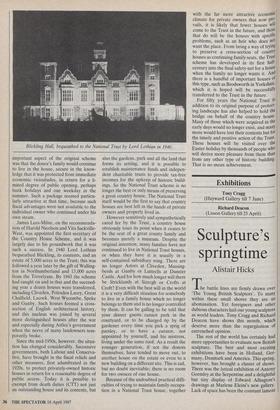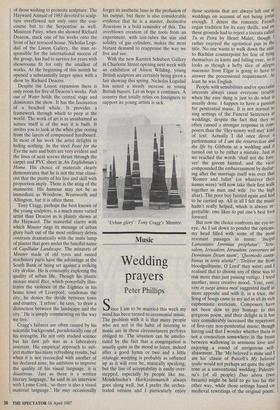Exhibitions Tony Cragg (Hayward Gallery till 7 June)
Sculpture's springtime
Alistair Hicks
The battle lines are firmly drawn over `The Young British Sculptors'. To many within these small shores they are an abomination. Yet foreigners and other dubious characters hail our young sculptors as world leaders. Tony Cragg and Richard Deacon have shows this month, which deserve more than the regurgitation of entrenched opinion. The rest of the world has certainly had more opportunities to evaluate new British sculpture. The best and most exciting exhibitions have been in Holland, Ger- many, Denmark and America. This spring, however, has brought a cluster of shows. There was the lyrical exhibition of Antony Gormley at the Serpentine and a delightful but tiny display of Edward Allington's drawings at Marlene Eleini's new gallery- Lack of space has been the constant lament of those wishing to promote sculpture. The Hayward Annual of 1983 devoted to sculp- ture overflowed not only onto the con- course but to the Serpentine as well. Maureen Paley, when she showed Richard Deacon, stuck one of his works onto the front of her terraced house. Nicholas Logs- dail of the Lisson Gallery, the man re- sponsible for the international success of the group, has had to survive for years with showrooms fit for only the smallest of works. At the beginning of this month he opened a substantially larger space with a show by Richard Deacon.
Despite the Lisson expansion there is only room for five of Deacon's works. Fish out of Water holds the central stage and dominates the show. It has the fascination of a beached whale. It provides a framework through which to peep at the world. The work of art is as unashamed as nature itself is of the way it is built. It invites you to look at the white glue oozing from the layers of compressed hardboard. In most of his work the artist delights in hiding nothing. In the steel Feast for the Eye the nuts and bolts are very evident and the lines of neat screws thrust through the carpet and PVC sheet in An Englishman's Home. His choice of materials clearly demonstrates that he is not the true classi- cist that the purity of his line and skill with proportion imply. There is the sting of the mannerist. His humour may not be as immediate as Woodrow, Wentworth and Allington, but it is often there.
Tony Cragg, perhaps the best known of the young sculptors, is a much more varied artist than Deacon as is plainly shown at the Hayward. The masterful clarity with which Minster rings its message of urban glory built out of the most ordinary debris contrasts dramatically with the mute lump of plaster that goes under the fanciful name of Capillular Landscape. The minarets of Minster made of old tyres and rusted machinery parts have the advantage at the South Bank of being set against a striking city skyline. He is constantly exploring the quality of urban life. Though his plastic mosaic mural Riot, which powerfully illus- trates the violence of the Eighties in his home town of Liverpool, condemns the city, he denies the divide between town and country. 'I refuse', he says, 'to draw a distinction between the landscape and the city.' He is simply commenting on the way we live.
Cragg's failures are often caused by his scientific background, paradoxically one of his strengths. He not only studied science but his first job was as a laboratory assistant. His empirical approach to sub- ject matter has many refreshing results, but when it is not reconciled with another of his declared aims, his ambition to improve the quality of his visual language, it is disastrous. 'Just as there is a written literary language,' he said in an interview with Lynne Cook, `so there is also a visual material language.' He may occasionally forget its aesthetic base in the profusion of his output, but there is also considerable evidence that he is a master. Instinctive Reactions is a bold reminder of this. The overblown creation of the tools from an experiment, with test-tubes the size and solidity of gas cylinders, makes the most blatant demand to reappraise the way we live and see.
With the new Karsten Schubert Gallery in Charlotte Street opening next week with an exhibition of Alison Wilding, young British sculptors are certainly being given a fair showing this spring. Nicholas Logsdail has noted a steady increase in young British buyers. Let us hope it continues. A country that totally relies on foreigners to support its young artists is sick.
'Urban glory': Tony Cragg's Minster.



















































 Previous page
Previous page